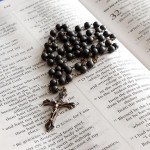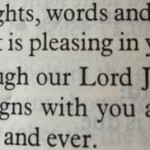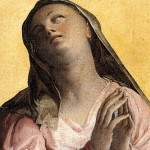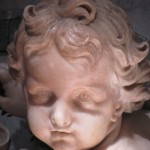Repost from 9/15/05
33 And his father and his mother marveled at what was said about him;
34 and Simeon blessed them and said to Mary his mother, “Behold, this child is destined to be the rise and the fall of many in Israel, and a sign that is spoken against
35 (and a sword will pierce through your own soul also), that thoughts out of many hearts may be revealed.”
The Gospel According to Luke, Chapter 2
Today’s gospel reading at Mass is one of my favorites – one I think on frequently. I like Simeon, who spends his days waiting in the Temple for the appearance of the Messiah – whose canticle we pray each night at Compline:
Lord, now you let your servant go in peace/your word has been fulfilled:
My own eyes have seen the salvation/which you have prepared in the sight of every people.
A light to reveal you to the nations/and the glory of your people Israel.
And I like Anna, the old woman who prays “night and day” in the Temple – though she is not quoted, I think of her as the first monastic sort of woman and so I cannot help but think fondly of her.
But it is this prophecy of Simeon that is most compelling. Imagine being a young mother, bringing your firstborn to Temple, in thanksgiving and obedience. Your baby is the tremendous new love of your life; a love you have never felt before has entered into your heart at his birth, and you will do anything – anything – to protect this child. There is no selfishness where this baby is concerned, only a complete surrender to his vulnerability, and to his own unconditional love.
And in this joy, you allow an old man to look into the face of this new creation…and the old man praises God for your wonderful baby and then tells you:
“…this child is going to be great, so great that the whole world will respond to his birth, and the response will never abate. And in that greatness, he will be the focus of tremendous love. And because he is great, he will also be the object of unfathomable hatred. He will be spoken against and contradicted – forever! Over him wars will be justly and unjustly fought. In his name men will justly and unjustly die. For his having come into the world, men and women will kill and be killed…and yet…over him great wars will be prevented or resolved. In his name, men will awaken from the sleep of the spirit and arise. For his having come into the world, men and women will perform great and lasting deeds of charity and unselfish love, which might otherwise never come into being…”
How Mary must have gasped to hear such a prophecy. To hear such jarring words spoken about the tiny, sleeping child she held to her chest. Perhaps at Simeon’s words, she held Jesus that much closer and thought – do not wish such awful things on my child, such terrible power and privilege! He is just my little boy…
Because no matter what the angel had told her, or what Mary had consented to, Jesus, Son of God, was also Son of Mary, and forever “just her little boy,” her most precious child.
And then to hear the words – “and your heart, too, will be pierced…” It seems a promise of unrelenting sorrow – a great mystery – that can only grieve a mother as she ponders the warm little body lying upon her breast.
I think it is interesting that Simeon made note of the suffering that Mary, in consenting to be the Mother of the Messiah, did agree to live through. And it’s interesting, too, that Luke also made note of it.
There are no accidents in scripture. Nothing is put in there as a “throw away,” that is, not really meant to be considered. Despite what Dan Brown and the DaVinci Coders contend, women are not minimized within the Gospel. Rather, every mention of a woman is meaningful, and when we read that Simeon, while prophesying on Jesus, did so on Mary, as well – I think it’s supposed to mean something. I think perhaps it means that Mary’s role in the life of the church, in the Christian experience did not end with the deliverance of her placenta and the taking of her ritual bath. Rather, Mary – The Mother – walked with and monitored every part of her son’s life (as mothers do) and his ministry. Far from being a toss-off, a mere minor player in the story of Christ and the Christian experience, Mary’s life is as entwined with Christ’s at his death as it was when he was living and growing inside her body. Her life is entwined in the whole of the story of Salvation.
She was there when Christ was found to be talking with great wisdom with the elders; she raised an eyebrow at him, noting that “your father and I have been worried sick, now you get over here and don’t take off on your own like that again!”
She was there at Cana, tugging at his sleeve and saying, “hey, these people have a need, please help them…” and to the waiters, “do as HE tells you…” (How I love this image of Mary, scurrying around, eagle-eyed, aware of everything and doing the Jewish/Italian/Irish/Hispanic/Everymother thing of bossing everyone around!)
She was there as he preached, and as he was arrested and tortured, and as he carried his cross. She was there – not running away – broken, yet completely faithful, as he died before her eyes, managing first to tell her that her work was only just beginning, that she had no time for a luxury of grief, because now she was to be The Mother to others, even as he told John that he (and we) were to hold her to that role.
She was there as the apostles hid in the upper room. Likely she was around the food, making everyone as comfortable as possible and raising the eyebrow again, wondering if these men would ever “get it.”
And she was there at Pentecost, when the Holy Spirit came down and the church was formed.
We don’t read about Mary in a “leadership” role in the Acts of the Apostles, but I suspect that this is because Mary’s leadership was lived in the guise of The Mother.
The guidance (and the role of overseer) which is part and parcel of a mother’s job is – while indespensible – rarely understood as “leadership.” This is as true today, in our “enlightened age” as it was in the “patriarchal Judean culture.” The attention to detail, the fussy “human” stuff, the work, wisdom, planning and supervisory/administrative role of a mother is as under-appreciated now as it was, then, but in either era it is the backbone of…well, if you really stop to consider, the role of The Mother is the backbone of everything that is and was and will be.
Luke does not write about Mary in the Acts, but it is not unthinkable that as the apostles were building up the church Mary was doing more than simply feeding people and washing clothes. I am sure she did do those things…but she was a mother – The Mother of the church – and so I am quite certain that aside from her domestic tasks Mary was pointing the apostles and those first followers in this direction and that saying, “make sure you talk to so-and-so,” “don’t forget about thus and such,” “did you remember to do this or that?” “I overheard such-and-such, you’d better be aware of that, and make sure you…”
That’s the affectionate watchfulness of The Mother, too often seen by her children as nagging, and it might have seemed like nagging to the apostles, too. But all of that meddling and observing and commenting has a tendency to beget planning and strategy and the foreseeing-and-overcoming of obstacles before they muck things up.
This is what mothers do. It is what – I have no doubt – Mary did, constantly at the service of the church, at the service of the apostles and the believers, serving them not only with her hands but with the wisdom of The Mother, gleaned over a lifetime of work and love.
Who knew Christ better than she? Who could explain to his sometimes thick-headed apostles what he was about, how the Canaanite woman who bested him in reason, (“but even the dogs eat the crumbs that fall from their masters’ table.“) probably pleased Jesus with her cleverness, not only because it demonstrated her faith, but because it nudged his good humor.
Perhaps she cued Luke (who tradition holds interviewed Mary, personally) into the fact that when Jesus said, regarding Herod, “Go tell that fox that I cast out demons and heal the sick…” that he was not merely giving forth information, but he was having fun with language, as well, by calling Herod a “fox,” which was another way of calling him (scripturally) a weakling, that he was a small, scuttling opportunist whom Christ did not fear.
Mary said “yes” to the Angel of the Lord. She was the Ark of the New Covenant, there at the beginning of the great pageant of Salvation.
She is here, now, the approachable Mother to whom countless parents and children turn when – exasperated or undone by human relations – they need a wise mother in whom to confide (except her answer is always the same, “Do whatever HE tells you…”) and she is in the time to come – Revelation 12 calls her “the woman clothed with the sun, with the moon under her feet,” the very image which, after 500 years, still shows itself on the rough, plant-fibered tilma of Juan Diego (and as the world wonders what to do about the People of the Crescent in our current age, there is something remarkably reassuring about that image, cast so long ago.)
But that is what a mother does. She reassures. She works for her family. She serves. She carries on and carries forward, doing the things that need to be done. Even if all the while, her heart is pierced with a sword of deep and lasting sorrow.
And we, who each carry within our own lives wounds both secret and open, have in this Sorrowful but Eternal Mother, a perfect confidante, a Mother to whom we can turn because we know she’s “been there, done that.” When a daughter keeps dubious company and a son gets himself in trouble, you can turn to Mary and say, “Mary…what am I to do with this child? Help!”
“Do,” she will counsel, over and over, “what He tells you…”












